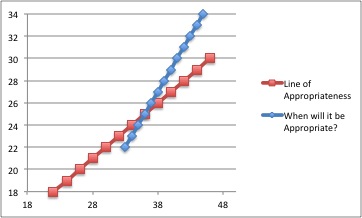The Issue
The formula 7+x/2 is a common formula for determining the socially acceptable age of a dating partner. Substantively, this dating age formula states that you should not date someone younger than half your age plus seven. Properly used, the formula provides an age band within which are ages that your partners should be. As pleasant as this rule is, it is mostly theoretical and demands a more applicable version. This post provides that more applicable version.
The Problem
The formula 7+x/2 only is useful when positing which people would be socially acceptable to date. This presents two specific problems. First, identifying entire universes of people who are ideal partners is an unproductive exercise in dreaming. For example, people generally want to date beautiful non-impoverished people who have no baggage and whose parents are delightful people. But as nearly everyone knows, only a fraction of the world dates beautiful people, most people are impoverished, everyone has baggage, and all but two parents are distinctly un-delightful. Furthermore, crafting these rules of I want to date this type of person or that type of person blinds or biases one against potential partners in your immediate social vicinity. These flaws make the formula about as valuable as commenting on the weather.
Even at its most useful, this formula is only helpful–and even then for just that moment–when you find someone you are considering dating and want to know whether that person is an acceptable age. The problem, though, is that the rule can only tell you the answer for that moment in time, not down the road. For example, you may be interested in someone “too” young for you now, but what about next year? The year later? You have to re-calculate every year. Fail.
The graph below illustrates how, at the present moment, it is inappropriate for a 33 year old to date a 22 year old, but that at some point in the future it will be appropriate. To explain a bit more: The red line is the minimum age for which it is appropriate to date someone. The X axis is the older person and the Y axis is the younger person. The blue line plots the ages of two people who are 33 and 22 now (next year, they are 34 and 23, etc.). The correct interpretation of this graph is that for any ages below the red line, it is inappropriate to date. For any ages at or above the red line, it is appropriate (Note: the upper limit is not taken into account in this chart). What should become clear is that even though it is inappropriate for a 33 and 22 year olds to date now, it becomes appropriate at some point in the future. And this switch in appropriateness happens in all cases (Note: again, this does not take into account upper level appropriateness).
In such situations, the crucial question becomes when is it appropriate to date someone? And that is the situation in most cases, as one can not choose anyone they want to date but, to put it crudely, is handed someone to date (i.e., the universe of possible partners is not infinite).
The Solution
As mentioned before, the important moment is when the slope of appropriateness (i.e., x/2+7) intersects with the line of how a given couple ages. You could either find the intercept point or add a time element to the original formula. Let’s do the latter (courtesy of MK), with t equaling the number of years, x being the older person’s age, and d being the age delta/difference:
ynow + t = (1/2)(xnow+t) + 7
t – (1/2)(t) = (1/2)(xnow) – ynow + 7
(1/2)(t) = (1/2)(xnow) – Ynow + 7
t = xnow – (2)(ynow) + 14
t = 2d – xnow + 14
And now let’s apply it with the 33 year old and 22 year old:
t = 2(11) – 33 + 14
t = 22 – 33 + 14
t = 3
When the older person is 36, it will be okay to date the other person (who will be 25). To check the formula, we can return to the original formula. One year earlier should be no good:
y = x/2 + 7
y = 35/2 + 7
y = 17.5 + 7
y = 24.5
No good, because when the older person is 35 the younger person will be 24 (we assume they are born on the same day).
Now to check the solution’s age:
y = x/2 + 7
y = 36/2 + 7
y = 18 + 7
y = 25
Yes! When the older person is 36, the younger person will be 25.
The Lesson
The most referred to dating-age rule, y=x/2+7, is inadequate for real-world situations, and a new rule is needed. The new rule should determine whether it is acceptable to date someone and, if not, how long you must wait to date someone. The formula ynow + t = (1/2)(xnow+t) + 7 does this. If t is zero or negative, it is okay to date the person now. If t is positive, one must wait that long to date the younger person.
The commonly used formula has other problems, and this site does a great job of exploring additional important angles of the half your age plus seven rule with some data.

Very good. Get her phone number and age, calculate when the relationship will become appropriate, and tell her you’ll call her then. Better set a reminder in your calendar.
Right.
Or just call her now because age is an imperfect measure–as are all measures–of maturity.